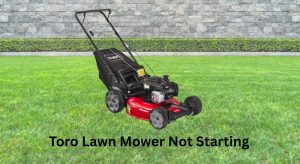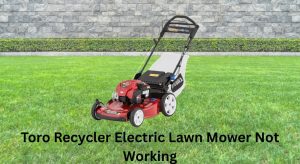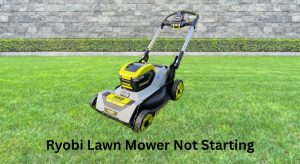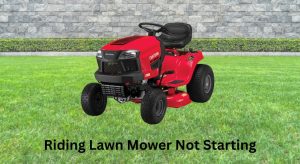When your DeWalt electric lawn mower won’t start, it can derail your entire yard day. Whether you’re using a DeWalt 20V/40V cordless mower like the DCMW220P2/DCMWSP255U2 or a corded model, a fast fix is often as simple as reseating the battery, charging fully, or clearing the safety bail handle. Quick fix: remove the battery, press the battery’s fuel gauge to confirm charge, clean the battery contacts, reinsert firmly until it clicks, then hold the safety bar and press the start button for 2-3 seconds.
In this guide, you’ll learn all the common causes of a DeWalt electric lawn mower not starting and step-by-step solutions—from battery and switch checks to deck clearing, blade/brake issues, thermal overload resets, and controller diagnostics. By the end, you’ll know exactly how to get your mower powered up and how to prevent future starting issues.
Common Causes of a DeWalt Electric Lawn Mower Not Starting
- Battery not fully seated or discharged
- Safety features not engaged (bail bar/start sequence)
- Wet grass, clogged deck, or jammed blade
- Battery or mower overheated (thermal protection)
- Faulty start switch, bail cable, or blade control
- Dirty or corroded battery terminals/contacts
- Key missing or incorrectly inserted (on select models)
- Damaged power cord (corded models) or bad outlet
- Controller, fuse, or wiring fault
- Storage-related issues (deep discharge, moisture)
How to Fix a DeWalt Electric Lawn Mower Not Starting

Method 1: Do the Fast Start Sequence Check
Diagnosing the Issue
Most DeWalt cordless mowers require two actions to start: pull and hold the safety/bail bar to the handle, then press and hold the start button. If you press the button first, it won’t start.
Fix Steps
- Remove the battery/batteries. Wait 10 seconds.
- Check battery charge on the pack’s LED fuel gauge. Charge if 1-2 bars or less.
- Inspect battery contacts on both the pack and mower for dirt, grass, or corrosion. Wipe with a dry cloth. For light corrosion, use isopropyl alcohol and a cotton swab. Let dry completely.
- Reinsert the battery firmly until you hear/feel a click. On dual-battery models, insert in the active slot (consult manual). Some models require both batteries inserted.
- Hold the bail bar (safety lever) fully to the handle. Then press and hold the start button for 2-3 seconds.
- Try again with a fully charged second battery if available.
Testing
- Motor should ramp within 1-2 seconds. If it clicks then stops, continue to Method 2.
Method 2: Clear Blade/Deck and Reduce Load
Diagnosing the Issue
A jammed blade or clogged deck can prevent the motor from starting or immediately trips protection. Wet, tall grass increases starting load.
Fix Steps
- Important: Remove battery before any deck/blade inspection.
- Flip mower on its side with air filter/battery compartment facing up to prevent debris ingress.
- Clear packed grass from under the deck and around the blade hub. Use a plastic scraper.
- Check blade for wraparounds (string, wire, rope) and remove carefully.
- Spin the blade by hand (gloves on). It should rotate freely with only mild resistance from the blade brake. If it’s seized, see Method 4.
- Mow on a higher cut setting first, or mow in drier conditions. Make a short test pass on a thinner area.
Testing
- Reinsert battery, perform the start sequence. If it starts, resume mowing in lighter cuts. If not, proceed.
Method 3: Address Battery and Thermal Protection
Diagnosing the Issue
Lithium-ion packs protect themselves when overheated, too cold, or deeply discharged. The mower’s controller also has thermal cutoff.
Fix Steps
- If the mower was used heavily or stored in the sun, let both mower and battery cool indoors for 20-30 minutes.
- For cold conditions (below 40°F/4°C), warm the battery to room temp (~68°F/20°C) before use.
- Fully charge the battery on a DeWalt charger. Check the charger’s LED codes. Solid light = charged; flashing patterns indicate temperature delay or fault (refer to your charger manual).
- Try a different known-good DeWalt battery of the same platform (20V/40V). If the mower starts with another pack, your original battery may be failing.
Testing
- Start mower after cool-down/charge. If the pack flashes error codes on the charger or never reaches full, consider battery replacement.
Method 4: Check the Blade Brake, Bail Cable, and Start Controls
Diagnosing the Issue
If the safety bail cable is loose or the blade brake is stuck engaged, the controller won’t allow the motor to run. A failed start button or bent handle sensor can also block starting.
Fix Steps
- Inspect the bail cable (the cable from the handle to the deck). It should tighten the brake lever when you pull the bail.
- With battery removed, pull the bail and watch the brake arm at the deck pivot. It should move freely. If sticky, apply a small amount of dry lubricant to the pivot and cycle it.
- Adjust cable tension: Many models include a thumb-adjuster or barrel adjuster near the handle. Tighten until the brake fully disengages when the bail is pulled, but the blade doesn’t spin with bail released.
- Check the start button: Press and feel for a decisive click. If mushy or intermittent, spray a tiny amount of contact cleaner into the switch area (avoid oversaturation) and actuate several times.
- Confirm any safety key or removable lock (if equipped) is inserted correctly.
Testing
- Reinsert battery and try starting while pulling the bail fully. If you must tug unusually hard, the cable needs more adjustment or replacement.
Method 5: Corded Model Power Checks (If Applicable)
Diagnosing the Issue
If you have a corded DeWalt mower or you’re using a cord for charging, power delivery faults may be the culprit.
Fix Steps
- Test the outlet with another tool. Reset GFCI or breaker if tripped.
- Inspect extension cord: Use a 12- or 14-gauge outdoor-rated cord of appropriate length. Damaged cords cause voltage drop or no power.
- Ensure the cord is fully seated in the mower’s inlet and strain relief is used to prevent pull-out.
- If the mower has a built-in breaker or reset switch, press to reset.
Testing
- Try a known-good outlet and shorter, heavier-gauge cord.
Method 6: Controller, Fuse, and Wiring Inspection
Diagnosing the Issue
After ruling out basics, the mower’s control board or internal wiring may have a fault. Signs include no response at all despite good battery, or brief spin then immediate cutout without load.
Fix Steps
- Important: Remove battery and wait 1 minute.
- Inspect the battery bay for bent, recessed, or burned contacts. Lightly straighten bent tabs with needle-nose pliers if safe to do so. Do not force.
- Check for visible wiring damage along the handle and into the deck—look for pinched wires at folding hinges.
- Some DeWalt mowers include an internal fuse or thermal switch accessible under the top cover. If comfortable and within warranty guidelines, remove the cover screws and inspect for a blade fuse or thermal reset. Replace fuses only with the exact rating.
- Look for signs of moisture intrusion, burnt components, or broken connectors on the controller. If present, stop and move to professional service.
Testing
- Reassemble carefully, insert battery, and test. If symptoms persist, service is recommended.
How to Prevent Future Starting Issues
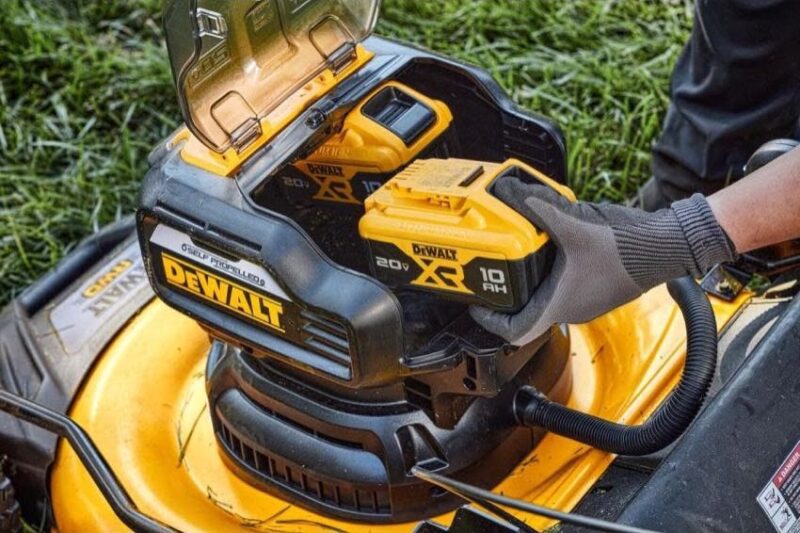
- Keep batteries between 20% and 80% when storing more than a month; avoid full discharge.
- Store batteries and mower indoors, dry, and at room temperature.
- Clean the deck after each mow; avoid cutting wet, heavy grass.
- Sharpen or replace blades each season to reduce startup load.
- Inspect and adjust the bail cable twice per season.
- Use only genuine DeWalt batteries/chargers for compatibility and protection logic.
Pro Tips
- Label your batteries and rotate them to balance wear.
- If the mower stops mid-mow, raise the deck one notch and take narrower passes to reduce load.
- For long grass, “double-cut”: first at a high setting, then lower to desired height.
- Keep a soft nylon brush in your shed to quickly clean battery contacts and vents each use.
- After washing the deck, let the mower air dry fully before inserting a battery to prevent controller moisture faults.
- Don’t hold the start button without pulling the bail—follow the exact sequence to avoid confusion with safety interlocks.
- If you experience frequent thermal shutdowns, mow earlier in the morning or later in the day and use a higher-capacity pack (e.g., 10Ah) for cooler operation.
When to Call a Professional
- You see sparking, burned contacts, or melted plastic in the battery bay.
- The motor tries to start, clicks, or hums, then stops with the deck clear and a good battery.
- There’s a persistent smell of burning electronics or visible moisture damage on the controller.
- The start switch or bail cable is broken and you’re not comfortable replacing it.
- The mower is under warranty—DIY disassembly may void coverage.
What to look for:
– Authorized DeWalt service centers or reputable small engine/electric tool repair shops.
– Technicians experienced with brushless DC controllers and Li-ion diagnostics.
– Clear estimates and parts availability.
Typical costs:
– Bail cable replacement: $20-$60 parts, $40-$90 labor.
– Start switch assembly: $15-$50 parts, $50-$120 labor.
– Controller board: $120-$250 parts, $100-$200 labor.
– Battery replacement: $79-$249 depending on capacity.
Warranty tips:
– Check DeWalt’s 3-year limited warranty and 1-year free service (varies by model and region). Batteries typically have separate coverage. Keep receipts and serial numbers.
FAQ
Q: Why does my DeWalt mower only click but not start?
A: A jammed blade, engaged brake, or low/dead battery is likely. Remove the battery, clear the deck, ensure the blade spins freely, fully charge the battery, and verify the bail cable disengages the brake before pressing the start button.
Q: My DeWalt battery shows full, but the mower won’t start. What now?
A: Clean and reseat the battery contacts, try another known-good battery, and verify the start sequence. A failing pack can show full but sag under load. If a second battery works, the original pack may need replacement.
Q: Can I start the mower while holding the start button first?
A: No. Most models require you to pull and hold the bail bar first, then press the start button. Reversing the sequence prevents starting.
Q: The mower shuts off immediately in thick grass. Is it broken?
A: Likely not. The controller senses overload. Raise deck height, slow your pace, take partial-width passes, and ensure the blade is sharp and the deck is clean.
Q: How do I reset thermal protection?
A: Remove the battery and allow the mower and battery to cool for 20-30 minutes indoors. Some models also have an internal thermal reset; simply cooling and restarting typically clears it.
Q: Do I need to replace the blade to fix starting problems?
A: A dull or bent blade increases startup load. If the blade is damaged, replace it. If only dull, sharpening can help. Always remove the battery before servicing the blade.
Q: Will a larger Ah battery help starting?
A: Yes. Higher-capacity packs (higher Ah) generally have lower voltage sag under load, improving startup reliability and runtime. Ensure it’s compatible with your mower platform.
Alternative Solutions
If repeated issues persist or your yard conditions are demanding, consider alternatives.
| Solution | Pros | Cons | Best For |
|---|---|---|---|
| Higher-capacity DeWalt battery (e.g., 10Ah) | Longer runtime, stronger starts | Higher cost, heavier | Larger lawns, thick grass |
| Self-propelled DeWalt model upgrade | Easier mowing, optimized control | More expensive | Sloped yards, bigger properties |
| Gas mower backup for peak growth | Powers through heavy, wet grass | Maintenance, emissions | Spring surge, infrequent heavy cuts |
| Professional lawn service | No equipment hassles | Ongoing cost | Busy schedules, large properties |
Get Your DeWalt Electric Lawn Mower Working Again
Following this guide, you now have multiple solutions to fix your DeWalt electric lawn mower not starting:
– Verify battery charge, clean contacts, and reseat properly
– Perform the correct safety start sequence with the bail bar
– Clear the deck and ensure the blade spins freely
– Let overheated batteries/mower cool and recharge fully
– Adjust or replace the bail cable and check the start switch
– Inspect wiring, contacts, and consider professional service for controller faults
Don’t let a no-start sideline your yard work. Try these methods in order, and you’ll likely have your DeWalt mower running smoothly again today.
Have you fixed your DeWalt electric lawn mower not starting? Share what worked for you so others can get back to mowing faster. Found this guide helpful? Bookmark it for future reference.


